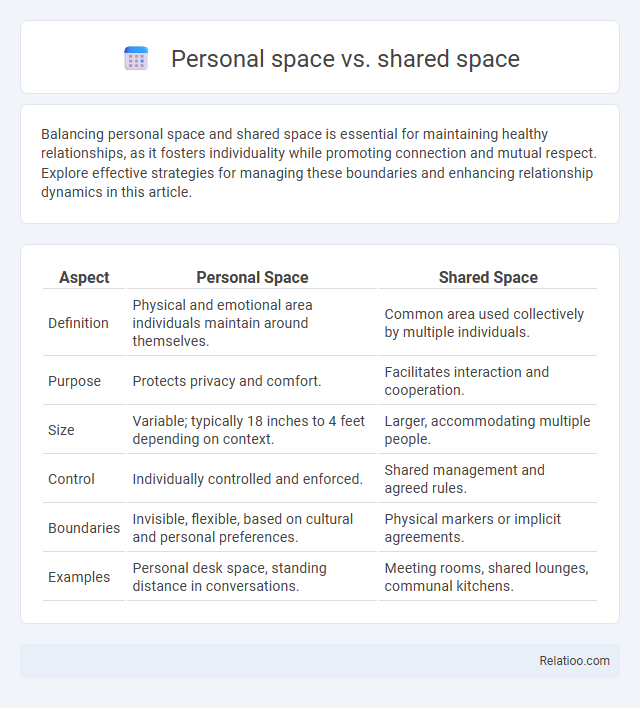Balancing personal space and shared space is essential for maintaining healthy relationships, as it fosters individuality while promoting connection and mutual respect. Explore effective strategies for managing these boundaries and enhancing relationship dynamics in this article.
Table of Comparison
| Aspect | Personal Space | Shared Space |
|---|---|---|
| Definition | Physical and emotional area individuals maintain around themselves. | Common area used collectively by multiple individuals. |
| Purpose | Protects privacy and comfort. | Facilitates interaction and cooperation. |
| Size | Variable; typically 18 inches to 4 feet depending on context. | Larger, accommodating multiple people. |
| Control | Individually controlled and enforced. | Shared management and agreed rules. |
| Boundaries | Invisible, flexible, based on cultural and personal preferences. | Physical markers or implicit agreements. |
| Examples | Personal desk space, standing distance in conversations. | Meeting rooms, shared lounges, communal kitchens. |
Understanding Personal Space
Understanding personal space is crucial for maintaining comfort and respect in social interactions, as it defines the invisible boundary individuals create around themselves. Personal space varies based on cultural norms, context, and the nature of relationships, influencing how close or distant you feel comfortable with others. Recognizing the difference between personal space, shared space, and general space helps prevent misunderstandings and promotes harmonious communication.
Defining Shared Space
Shared space represents an environment designed for multiple users to interact harmoniously, balancing personal comfort with communal accessibility. Your experience within shared space depends on clear boundaries, mutual respect, and thoughtful design that promotes collaboration while maintaining individual autonomy. Unlike strictly personal or entirely open spaces, shared space optimizes interaction and functionality for collective benefit.
The Psychology Behind Personal Boundaries
Personal space is a critical psychological concept defining the invisible boundary individuals maintain to feel secure and comfortable, directly influencing social interactions and emotional well-being. Shared space requires negotiation of these personal boundaries to foster cooperation and mutual respect, balancing individual needs with group dynamics. Understanding your personal space needs helps manage stress and reinforces healthy relationships by respecting both your comfort zone and the communal environment.
Benefits of Maintaining Personal Space
Maintaining personal space enhances your comfort and reduces stress by creating clear boundaries that respect individual privacy and autonomy. In shared spaces, honoring personal space fosters better communication, minimizes conflicts, and promotes a harmonious environment. Proper management of these spatial dynamics contributes to improved mental well-being and social interactions.
Advantages of Shared Spaces
Shared spaces foster collaboration, enhance creativity, and improve communication between team members by providing a dynamic environment where ideas flow freely. These spaces maximize resource efficiency, reduce real estate costs, and promote social interaction, leading to stronger workplace relationships. Your organization benefits from increased flexibility and adaptability when utilizing shared spaces, in contrast to the isolation of personal space or the rigidity of traditional office layouts.
Common Conflicts Between Personal and Shared Spaces
Conflicts between personal and shared spaces often arise from differing expectations regarding privacy, noise levels, and cleanliness. You may experience tension when personal boundaries are overlooked in communal areas, leading to discomfort or disputes. Establishing clear guidelines and mutual respect is essential to balancing individual needs with shared environment harmony.
Strategies for Balancing Personal and Shared Areas
Effective strategies for balancing personal and shared spaces include clear communication of boundaries and schedules to respect individual preferences while fostering collaboration. Utilizing flexible furniture and zoning techniques helps define distinct areas without compromising openness, optimizing space usage in homes or offices. Incorporating storage solutions and regular decluttering maintains organization, ensuring both personal and shared environments remain functional and comfortable.
Cultural Differences in Space Perception
Cultural differences significantly influence the perception of personal space, shared space, and general space, affecting interpersonal interactions and social behaviors. In collectivist cultures, shared space is often embraced, with closer physical proximity and less emphasis on personal boundaries compared to individualistic cultures that prioritize personal space and privacy. Understanding these cultural nuances in spatial perception is crucial for effective communication and fostering respectful social environments across diverse cultural settings.
The Impact of Technology on Space Boundaries
Technology significantly blurs the boundaries between personal space, shared space, and physical space by enabling constant digital connectivity through smartphones, social media, and virtual environments. Your online presence often merges with physical environments, expanding personal space beyond traditional limits and reshaping how shared space is experienced and negotiated. This transformation impacts privacy, social interactions, and spatial awareness, requiring new guidelines and awareness of digital etiquette to maintain balanced and respectful spatial boundaries.
Tips for Respecting Both Personal and Shared Spaces
Respecting personal space involves maintaining appropriate physical distance, recognizing individual boundaries, and avoiding intrusive behaviors that may cause discomfort. In shared spaces, clear communication, cleanliness, and considerate use of common resources promote harmony and mutual respect among users. Balancing personal and shared space etiquette enhances social interactions and fosters a trustworthy and cooperative environment.

Infographic: Personal space vs Shared space
 relatioo.com
relatioo.com